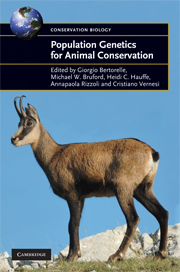Book contents
- Frontmatter
- Epigraph
- Contents
- List of contributors
- Foreword
- Acknowledgements
- 1 Introduction
- Statistical approaches, data analysis and inference
- 2 Statistical methods for identifying hybrids and groups
- 3 How to use MIGRATE or why are Markov chain Monte Carlo programs difficult to use?
- 4 Nested clade phylogeographic analysis for conservation genetics
- 5 A comparison of methods for constructing evolutionary networks from intraspecific DNA sequences
- Molecular approaches and applications
- From genetic data to practical management: issues and case studies
- Future directions in conservation genetics
- Software index
- Species index (common name)
- Species index (Latin name)
- Subject index
2 - Statistical methods for identifying hybrids and groups
from Statistical approaches, data analysis and inference
Published online by Cambridge University Press: 05 July 2015
- Frontmatter
- Epigraph
- Contents
- List of contributors
- Foreword
- Acknowledgements
- 1 Introduction
- Statistical approaches, data analysis and inference
- 2 Statistical methods for identifying hybrids and groups
- 3 How to use MIGRATE or why are Markov chain Monte Carlo programs difficult to use?
- 4 Nested clade phylogeographic analysis for conservation genetics
- 5 A comparison of methods for constructing evolutionary networks from intraspecific DNA sequences
- Molecular approaches and applications
- From genetic data to practical management: issues and case studies
- Future directions in conservation genetics
- Software index
- Species index (common name)
- Species index (Latin name)
- Subject index
Summary
INTRODUCTION
Recently, statistical geneticists have developed a number of model-based methods that use genetic data to infer the population of origin of the gene copies within an individual. In this chapter we focus on three of these methods which are known by the software that implements them: STRUCTURE (Pritchard et al. 2000), NEW HYBRIDS (Anderson and Thompson 2002) and BAYESASS + (Wilson and Rannala 2003). These programs are increasingly used in animal conservation for population assignment, detection of hybridization and estimation of recent migration rates. Unlike more generic statistical approaches (Bowcock et al. 1994; Roques et al. 2001), the three methods we review here are all based on an underlying probability model that is intended to mimic the inheritance of genes and the sampling of individuals. Such model-based inference has a number of advantages. First, it typically uses more of the information in the data than approaches that are not based explicitly on genetic models, and second, the variables appearing in genetically based statistical models relate directly to genetic phenomena, so they are easily interpreted.
The statistical genetic models underlying STRUCTURE, NEW HYBRIDS and BAYESASS + are simple and quite similar. The primary goal of this chapter is to describe these models with as few equations as possible. In lieu of mathematical equations we will explore the structure of these models in terms of simple, intuitive diagrams called directed acyclic graphs (DAGs), which show the relationship between variables in a model. This should allow users to better understand what the methods do, how they are similar, and the important ways in which they differ. Though the softwares implementing these techniques are user-friendly, they are certainly not ‘plug-andplay’ methods. I hope that this chapter will allow users to understand the methods enough to ensure they get reasonable results and they can interpret them appropriately.
- Type
- Chapter
- Information
- Population Genetics for Animal Conservation , pp. 25 - 41Publisher: Cambridge University PressPrint publication year: 2009
- 7
- Cited by

